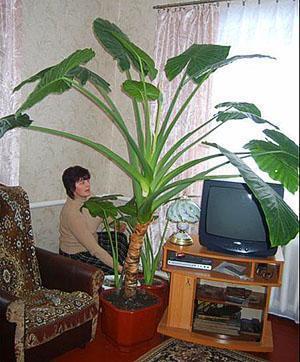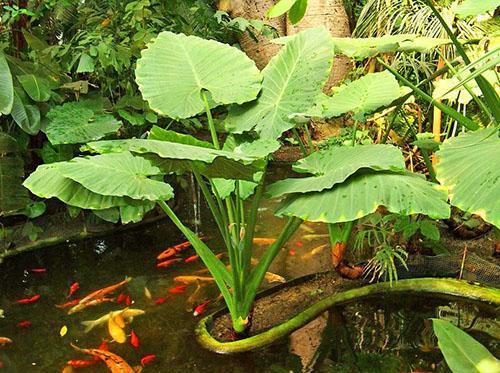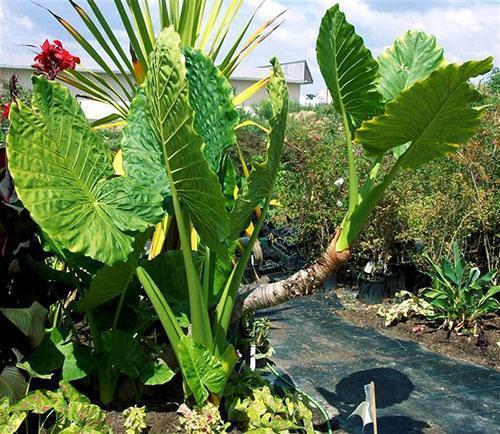Large types of alocasia
 The genus alocasia unites both tiny plants, no more than 15 cm in height, and giants under three meters in height. At the same time, types of alocasia with foliage similar to African masks or spearheads are mostly small plants that can decorate the home collection of an amateur florist. But the varieties that have earned the nickname "elephant ears" may not always even fit in a city apartment.
The genus alocasia unites both tiny plants, no more than 15 cm in height, and giants under three meters in height. At the same time, types of alocasia with foliage similar to African masks or spearheads are mostly small plants that can decorate the home collection of an amateur florist. But the varieties that have earned the nickname "elephant ears" may not always even fit in a city apartment.
In the spacious rooms of country houses, cottages, lovers of alocasia have the opportunity to place both large and small specimens.
Alocasia odora

Really large, as in the photo, fragrant alocasia can be found in the humid forests of East and Southeast Asia, for example, in the tropical regions of Japan and China, in Assam, Bangladesh and Borneo.
 Alocasia odora is known as the "night lily". Such a nickname for the plant, and its official name, appeared thanks to the fragrant, creamy inflorescences that appear in the summer. The ear of this type of alocasia is light pink or yellowish-cream, and the 20-centimeter long perianth has a silvery or bluish-green tint.
Alocasia odora is known as the "night lily". Such a nickname for the plant, and its official name, appeared thanks to the fragrant, creamy inflorescences that appear in the summer. The ear of this type of alocasia is light pink or yellowish-cream, and the 20-centimeter long perianth has a silvery or bluish-green tint.
 The height of an adult alocasia can reach 3.65 meters, and the luxurious leaves are used by the local population as fans or umbrellas during the seasonal rains. In North Vietnam, the petioles of alocasia odora are used to prepare folk remedies for cough, fever and all kinds of pain.
The height of an adult alocasia can reach 3.65 meters, and the luxurious leaves are used by the local population as fans or umbrellas during the seasonal rains. In North Vietnam, the petioles of alocasia odora are used to prepare folk remedies for cough, fever and all kinds of pain.
The plant is inedible due to the high content of calcium oxalate in greenery and underground parts. And in Japan, the local health ministry even issued a decree banning the consumption of alocasia in food. This is due to the similarity of the odora species with the edible plants Colocasia Gigantea and Colocasia esculenta.
Alocasia gageana
 The type of alocasia shown in the photo is very similar to the already described plant, but much lower than the odorous alocasia. The variety that got into the gardens of America and other countries from Malaysia grows only up to 1.5 meters. The leaves of this species are bright green, with wavy edges and a pointed tip. On a 50-centimeter-long leaf blade, depressed veins are clearly visible. The plant is thermophilic and demanding on the composition of the soil and the abundance of moisture.
The type of alocasia shown in the photo is very similar to the already described plant, but much lower than the odorous alocasia. The variety that got into the gardens of America and other countries from Malaysia grows only up to 1.5 meters. The leaves of this species are bright green, with wavy edges and a pointed tip. On a 50-centimeter-long leaf blade, depressed veins are clearly visible. The plant is thermophilic and demanding on the composition of the soil and the abundance of moisture.
Alocasia Calidora
 Thanks to the breeding work of Leri Ann Gardner, the growers received the hybrid alocasia Calidora, bred by interspecific crossing of alocasia scent and alocasia gageana.
Thanks to the breeding work of Leri Ann Gardner, the growers received the hybrid alocasia Calidora, bred by interspecific crossing of alocasia scent and alocasia gageana.
This plant produces large, upright leaves on strong cuttings that can grow up to a meter in length. The leaf plates of alocasia calidor, as in the photo, are quite thick, with a rounded upper edge and an elegant sharp tip. In a warm tropical climate, plants grow to 160–220 cm in height.
Hybrid Alocasia odora and Alocasia reginula
 The interspecific hybrid obtained from crossing alocasia odora and alocasia reginula also has a purple or brownish back side of the leaf plate. The plant in appearance turned out to be closer to fragrant alocasia, but much smaller in size. On the leaves of this type of alocasia, which are more dense than that of odor, the texture characteristic of reginal and streaks extending from light veins are clearly visible.
The interspecific hybrid obtained from crossing alocasia odora and alocasia reginula also has a purple or brownish back side of the leaf plate. The plant in appearance turned out to be closer to fragrant alocasia, but much smaller in size. On the leaves of this type of alocasia, which are more dense than that of odor, the texture characteristic of reginal and streaks extending from light veins are clearly visible.
Alocasia wentii
 Shown in the photo, alocasia vena, although similar to the species described, cannot be compared with them either in height or size of leaves. This perennial plant is rarely larger than 120 centimeters. She has large, cordate-oblong leaves of a gray-green hue with a noticeable silvery reflection and a purple back.
Shown in the photo, alocasia vena, although similar to the species described, cannot be compared with them either in height or size of leaves. This perennial plant is rarely larger than 120 centimeters. She has large, cordate-oblong leaves of a gray-green hue with a noticeable silvery reflection and a purple back.
Alocasia brancifolia
 Silvery foliage is common to many types of alocasia. The plant shown in the photo is no exception. In addition, alocasia branchifolia, reaching a meter in height, has variegated, greenish or brown stems and lobed leaves unusual for representatives of the alocasia species. The leaf plates are deeply cut, pointed, smooth. the plants bloom, forming whitish-pinkish inflorescences hidden by larger green bedspreads.
Silvery foliage is common to many types of alocasia. The plant shown in the photo is no exception. In addition, alocasia branchifolia, reaching a meter in height, has variegated, greenish or brown stems and lobed leaves unusual for representatives of the alocasia species. The leaf plates are deeply cut, pointed, smooth. the plants bloom, forming whitish-pinkish inflorescences hidden by larger green bedspreads.
Alocasia portei
 Even more interesting foliage in one of the largest representatives of the species - Potrei alocasia. A powerful plant, 2 to 6 meters high, is almost lignified in the lower part, and its strong stem can reach 40 cm in diameter.
Even more interesting foliage in one of the largest representatives of the species - Potrei alocasia. A powerful plant, 2 to 6 meters high, is almost lignified in the lower part, and its strong stem can reach 40 cm in diameter.
 The length of powerful dark green petioles with veins is one and a half meters. The leaf plates can also grow up to one and a half meters in length, and they are feathery, deeply cut and leave the impression of leathery. The edges of the leaves are wavy, which only adds decorative effect to this unusual type of alocasia.
The length of powerful dark green petioles with veins is one and a half meters. The leaf plates can also grow up to one and a half meters in length, and they are feathery, deeply cut and leave the impression of leathery. The edges of the leaves are wavy, which only adds decorative effect to this unusual type of alocasia.
On adult specimens, you can count up to 6-8 large, up to 30 cm long, inflorescences. This type of alocasia, as in the photo, likes to settle in dense thickets, where the surrounding vegetation provides it with shade and helps to maintain soil moisture.
Alocasia Portodora
 The hybrid of alocasia odora and alocasia portei obtained at the aroid research center was named portodora alocasia. The powerful plants of the bred species are recognized by many lovers of alocasia as more interesting than the famous alocasia macrorrhizos or large-rooted.
The hybrid of alocasia odora and alocasia portei obtained at the aroid research center was named portodora alocasia. The powerful plants of the bred species are recognized by many lovers of alocasia as more interesting than the famous alocasia macrorrhizos or large-rooted.
Giant leaves cling to upright brownish or purple sinewy petioles. The shape of the leaf plate is close to the foliage of alocasia odor, but from the pontea it inherited beautiful wavy jagged edges.
The plant has a good growth rate. Already in the first year, if conditions permit, it grows to one and a half meters. And then it can easily step over the 2.5 meter bar. For this, this type of alocasia requires increased air and soil humidity, abundant nutrition and warmth.
Alocasia macrorrhiza
 This type of alocasia, belonging to the aroid family, was apparently one of the first to be discovered and described by scientists. Living in tropical thickets of India and other South Asian countries, large, up to 5 meters high, plants in different regions are called Indian alocasia, as in the photo, mountainous, large-rhizome or medicinal. The officially recognized name for the species is alocasia macrorrhiza.
This type of alocasia, belonging to the aroid family, was apparently one of the first to be discovered and described by scientists. Living in tropical thickets of India and other South Asian countries, large, up to 5 meters high, plants in different regions are called Indian alocasia, as in the photo, mountainous, large-rhizome or medicinal. The officially recognized name for the species is alocasia macrorrhiza.
Its thick, succulent shoots grow to a length of 120 cm, leaves of alocasia large-rooted oval-arrow-shaped, dense. The length of the leaf plates is 50–80 cm, their surface is smooth and uniformly green.
 When Indian alocasia, as in the photo, is about to bloom, a strong, erect peduncle appears from the bosom, about 30 cm long. The length of the yellowish-green perianth reaches 18-25 cm, the light cream inflorescence is almost slightly shorter than the bedspread. Ripening berries are larger than other types of alocasia. A single scarlet fruit containing light brownish seeds reaches 10 mm in diameter.
When Indian alocasia, as in the photo, is about to bloom, a strong, erect peduncle appears from the bosom, about 30 cm long. The length of the yellowish-green perianth reaches 18-25 cm, the light cream inflorescence is almost slightly shorter than the bedspread. Ripening berries are larger than other types of alocasia. A single scarlet fruit containing light brownish seeds reaches 10 mm in diameter.
 Among local peoples, rhizomes, tubers and the lower parts of the stem of alocasia montana are usually eaten. To do this, the cleaned pulp is chopped and fried to neutralize the acrid taste imparted by calcium oxalate. Raw greens are eaten by pets and monkeys, which led to the appearance of another name for the plant - the monkey tree.
Among local peoples, rhizomes, tubers and the lower parts of the stem of alocasia montana are usually eaten. To do this, the cleaned pulp is chopped and fried to neutralize the acrid taste imparted by calcium oxalate. Raw greens are eaten by pets and monkeys, which led to the appearance of another name for the plant - the monkey tree.
The tubers of alocasia medicinal, in the photo, are considered a healing remedy for many diseases and are used in Chinese, Indian and Vietnamese folk medicine.
In addition to plants with even green foliage, today you can see a photo of alocasia with unusual variegated leaves, on which green areas are interspersed with white or yellow. The most prized alocasia large-rooted Variegata, which has, as in the photo, spectacular foliage and relatively small size.
 The Black stem alocasia macrorrhiza shown in the photo stands out from a number of related plants with dark purple or brown stems and leaf petioles, which is the reason for the name of the variety.
The Black stem alocasia macrorrhiza shown in the photo stands out from a number of related plants with dark purple or brown stems and leaf petioles, which is the reason for the name of the variety.
 The maximum size of large-rooted alocasia of this variety is 2.5 meters, which allows growing crops in large containers. The leaves of the plant are green, large, reaching 90 cm in length.
The maximum size of large-rooted alocasia of this variety is 2.5 meters, which allows growing crops in large containers. The leaves of the plant are green, large, reaching 90 cm in length.
 Alocasia large-rooted plumbea, or metallica, affects dense leaves with an obvious metallic sheen. A silvery tint is also present on the back of the leaf plates. The petioles of this variety are brown or purple. The height of an adult plant does not exceed 2 meters, and scientists were lucky to see wild-growing specimens in the tropical jungle on the island of Java.
Alocasia large-rooted plumbea, or metallica, affects dense leaves with an obvious metallic sheen. A silvery tint is also present on the back of the leaf plates. The petioles of this variety are brown or purple. The height of an adult plant does not exceed 2 meters, and scientists were lucky to see wild-growing specimens in the tropical jungle on the island of Java.
please tell me how this flower is called ??
looking for a shade-tolerant plant. I wanted to buy an aglaonema, but in the store I saw alocasia and began to read about it. In some articles they write that with a lack of light, the leaves will shrink and dry. I need to put the plant 5 meters from the northwest window. You can turn on the light, but it will not stay on all the time. Maybe it's better to return to Aglaonema?
Alocasia is definitely not suitable for you. In the depths of the room, it should only be placed in the summer to protect it from the sun. You have a window and alocasia will feel comfortable next to it. Lack of light will cause loss of decorativeness of the sheet plates. Aglaonema remains.